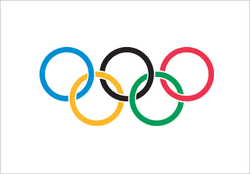Olympic flag
|
|
Olympicflagsaltlakecity.jpg
The Olympic flag represents the Olympic movement. It has a white field and five interlocking rings coloured blue, yellow, black, green, and red.
| Contents |
Use of the Olympic flag
An Olympic flag is raised during the opening ceremonies of each Olympic Games, and lowered during the closing ceremonies. A second flag is used for the Olympic Oath. Special are the flags kept in the cityhalls of cities organising the Olympic Games. At the end of the Olympic Games, the mayor of the city that organised the Games returns the flag to the president of the IOC, who then passes it on to the mayor of the next city to host the Olympic Games. There are three such flags, differing from all other copies in that they have a six-coloured fringe around the flag, and are tied with six coloured ribbons to a flagstaff.
- The Antwerp flag
- Was presented to the IOC at the 1920 Summer Olympics by the city of Antwerp, Belgium, and was passed on to the next organising city of the Summer Olympics until the Games of Seoul 1988.
- The Oslo flag
- Was presented to the IOC at the 1952 Winter Olympics by the city of Oslo, Norway, and is passed on to the next organising city of the Winter Olympics.
- The Seoul flag
- Was presented to the IOC at the 1988 Summer Olympics by the city of Seoul, South Korea, and is passed on to the next organising city of the Summer Olympics.
Olympic Emblem
The flag features the emblem of the Olympic Games — five interlocking rings (blue, yellow, black, green, and red respectively) on a white field — designed by Baron Pierre de Coubertin, the founder of the modern Olympic Games. The Baron de Coubertin introduced the emblem in the August edition of Revue Olympique in 1913 as a symbol and flag for the Olympic Congress in Paris in 1914:
- The emblem chosen to illustrate and represent the world Congress of 1914 ...: five intertwined rings in different colours - blue, yellow, black, green, red - are placed on the white field of the paper. These five rings represent the five parts of the world which now are won over to Olympism and willing to accept healthy competition.
- Moreover, the six colours thus combined reproduce those of all the nations without exception. The blue and yellow of Sweden, the blue and white of Greece, the French, British, American, German, Belgian, Italian, and Hungarian tricolours, the yellow and red of Spain lie next to the new Brazilian and Australian flags, and the old Japan and the young China. This is really an international emblem.
At the congress the flag was adopted as flag for the Olympic Movement. The first games the flag flew at were the VIIth Olympiad in Antwerp, Belgium in 1920.
The current view of the International Olympic Committee is that the "five rings represent the five continents". In this scheme, the Americas is viewed as a single continent, and Antarctica is omitted.
Interpretations of the coloured rings
Though the Baron de Coubertin obviously considered the rings and colours as two independent characteristics, and even though the IOC explicitly states (http://www.olympic.org/uk/utilities/faq_detail_uk.asp?rdo_cat=10_39_0) no ring represents a specific continent, still some people list matches. These are some such lists. (Since users of each list claim that list to be the explanation in general use, they are ordered here alphabetically according to the arbitrary, somewhat explanatory titles.)
A Map, Of Sorts
Coloured People, Blue Ocean
Coloured People, Greek Flag
et:Olümpialipp el:Ολυμπιακή σημαία fr:Drapeau olympique it:Bandiera olimpica nl:Olympische vlag pl:Flaga olimpijska
External Links
The Olympic symbols (http://multimedia.olympic.org/pdf/en_report_672.pdf)

